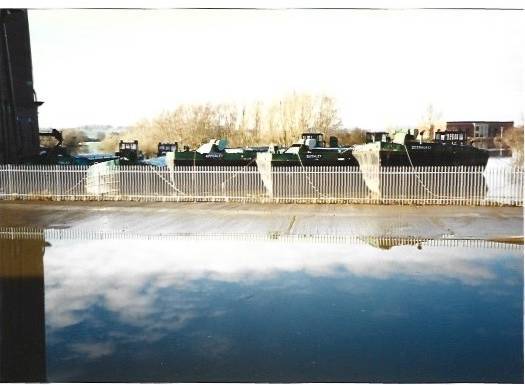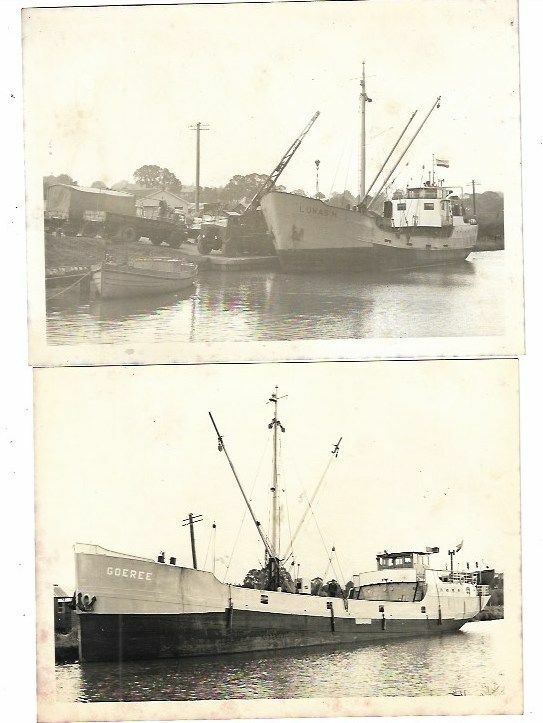

Stilllearning
-
Posts
2,871 -
Joined
-
Last visited
-
Days Won
43
Content Type
Profiles
Forums
Events
Gallery
Blogs
Store
Posts posted by Stilllearning
-
-
45 minutes ago, MtB said:
QUANGO = quasi-autonomous national government organisation, IIRC.
Non governmental
-
 3
3
-
-
All those musical references do rather hint at the age profile of us all.
-
Did perhaps someone try to flush it out by opening top paddles?
-
47 minutes ago, Tony Brooks said:
I very much doubt it, the Zanusi add states "inverter motor", that I suspect is marketing speak for one of the modern permanent magnet rotor with switched stator fields, that control speed and rotation by the order and speed at which the fields are pulsed - note suspect.
I have a feeling that the electronics may be more susceptible to poor wave form than earlier motor types.
Ok, thanks. I mentioned induction motor, because our new machine says that is what it has.
-
Is it possible that the op is thinking of an induction motor?
-
Hi, what engine is it? I ask, because some really are very easy to do a basic self service, while others are best left to more experienced hands, but equally, learning to do the work yourself is a wise long term plan.
-
On 06/03/2024 at 10:12, Arthur Marshall said:
Which presumably it can. CRT, however, as lower in the contractual pecking order, has no say in the matter. I'm sure the guys who run CRT are doing well out of it, as all heads of charitable organisations do. When the money runs out, they move on to another sinecure about which they know (and care) nothing, usually for a higher pay rate. As I once pointed out, Parry knows an awful lot about trains.
On your final point, my wife, an ex TfL employee and erstwhile pa to Parry, would disagree.
-
-
15 minutes ago, Iain_S said:
Petrol or diesel? A petrol engine is far more likely to escape damage, as the lower compression ratio allows greater valve/piston clearance.
My mother's Ka broke its cam chain in Brittany, but she was only doing about 20mph, as usual, and got away with just a valve or two, plus done free as it turned out her car should have had a recall for a cam chain defect.
-
41 minutes ago, davidwheeler said:
I am sorry if these don't appeal to you, but they do to me and I doubt they get much publicity so here is the 'Deerhurst', yard number 202 built by Charles Hill & Sons of Bristol in 1933, and 158 gross tons. The one of the three with a motor. The other shows all five of the fleet. 'Bushley' and 'Apperley' built by Hills in 1934 and 1933 respectively, yard numbers 210 and 203, both of 145 gross tons. Built for S. Healing and Sons. 'Tirley,' at far left, built in 1973 by John Harker of Knottingley for the Flixborough Shipping Co Ltd, 186grt, and 'Chaceley' built in 1964 by Harkers 167 grt. Both purchased by Allied Mills in 1975 and converted by R W Davis Shipyard at Saul for self discharging. I do not think they remained much longer together before the three originals were sold off. 'Bushley' remained in the Severn and may well still be so. The other two were sold. One appeared in Bideford for conversion into accommodation. The other I saw in Barnstaple some years ago. Great vessels, all three.
These photos appeal to me. I spent time in the 90s boating around Tewkesbury and liked the mill and its surroundings.
-
2 minutes ago, junior said:
Bought myself this can recently online unseen. Very happy with the price I paid for it. It was advertised as being about fifty years old, but other than that the seller didn't really seem to know what it was, where it came from etc...
What are people's thoughts? I know Taylor Brothers was a business on Trafford Park by the Bridgewater Canal, but don't know why they'd have a can painted. There's also Taylors boatyard in Chester, but I'm not sure they were ever known as Taylor Bros?
Could be just a couple of brothers with the surname Taylor that decided to get a can painted I suppose.
That's a very attractive can, but I can't help with the history, sorry.
-
Just now, MtB said:
I suspect that *may* not have been the one the 'professional chef' in the programme owned and was talking about...!
I know, but considering how few people actually need a professional quality pan, I thought I'd point out to the assembled masses that there are sensibly priced cast iron pots and pans available.
-
 1
1
-
-
21 hours ago, MtB said:
Curiously they were discussing exactly this on the wireless a couple of days ago, and apparently yes you can.
One of the chef bods taking part said, like you, that his top quality cast iron frying pan was better than non-stick pans. Trouble is, the current price of it is well into four figures!
I suppose that €79.99 counts as 4 figures.
-
1 hour ago, GUMPY said:
Hopefully those downwind of you enjoy breathing particulates😱 it's as bad as the exhaust from a diesel car.
With a population density of 64/sq kilometre in the commune, in a department with an average density of 67/sq kilometre, I'm not worried for any of my neighbour's health.
Added info: the department has about 375000 population, of which 50% live in one city. So the average density of population outside of our little town is very low indeed.
-
23 minutes ago, GUMPY said:
There are many London boaters that believe that they are green burning wood and living in a boat. One got particularly abusive when I pointed out that burning wood wasn't "green" and E-coal was better for the planet. Accused me of destroying the planet by living in a house 😱
On a bag of E-coal it says that it's made of 50% renewable materials, and their website doesn't say what the other 50 % is. I think I'll carry on using wood from local woodlands.
-
I believe that a dry sump engine has a separate but connected oil tank.
-
There are times on here that the lack of sympathy astonishes and depresses me.
-
46 minutes ago, davidwheeler said:
Perhaps having seen the inside of these two ships, you might like to see the outside. Again, if things work. The Lucas M was built in Tjamsweer, Holland in 1948. The Goeree, in 1927, by the well-known yard of Noord Neds Scheeps, Groningen. Although only 21 years between them, a world of difference in building techniques. Both in their way, handsome ships. On this day in October 1966, both ships were unloading below the Countesswear swing bridge, which carried the main Taunton to Plymouth/Cornwall road. Due I think to a canal closure through installation of new gates at Double Locks.
I mentioned unloading oyster shell. I recall from photos I took, that when unloading in the Basin and with the ship tied up adjacent to the warehouse, the bags were lifted by the ship's equipment out of the hold and
 onto a platform and then each bag loaded, by hand, onto an electric elevator and thus up to the first floor. I spoke once to a deckhand about this. He said, in Dutch, something like "It is ****** hard work this all *****day." That was the gist of it. Luckily, just across the river, by ferry, was a favourite pub. The wooden motorboat in the foreground of Lukas M. was there to help guide the ship backwards to the wide open stretch of the canal at Limekilns, where there was room to swing. Without that she would have been stuck until the canal reopened to the turning bay in the Basin.
onto a platform and then each bag loaded, by hand, onto an electric elevator and thus up to the first floor. I spoke once to a deckhand about this. He said, in Dutch, something like "It is ****** hard work this all *****day." That was the gist of it. Luckily, just across the river, by ferry, was a favourite pub. The wooden motorboat in the foreground of Lukas M. was there to help guide the ship backwards to the wide open stretch of the canal at Limekilns, where there was room to swing. Without that she would have been stuck until the canal reopened to the turning bay in the Basin.
I love the lines of those old ships, so elegant.
-
20 minutes ago, Stroudwater1 said:
Thanks for such an interesting set of postings. It must have been a thrill to get so near to these vessels. Docks now seem impenetrable and folk are kept well away, a pity for many reasons . Many dock/ ports seem to have these Double locks type establishments, there was similar with similar stories at Sharpness.
Where was the oyster shell taken? Would it have gone for compost with peat extraction and horticulture in the Somerset and Devon areas?
The Double Locks was an exceptional boozer and eatery back in the day, and is still pretty good.
ETA
historically the building was I believe the offices of the Dutch merchants who traded up to Exeter. If you look at the building, the Dutch influences are fairly clear.
-
3 minutes ago, Clanky said:
i have a header tank for the engine and one for the eberspacher? There is an inline screw isolating valve just after the thermostat like yours. If i were to shut this valve then should this prevent the HW circulating around the engine and keep the water hotter for longer as atm the engine is just acting like a big radiator, as long as i remember to open it again when running the engine of course?
And put a note next to the ignition switch to remind you to open the valve each time you start the engine!
-
 1
1
-
-
I knew the Double Locks well in the 80s and 90s as the landlord was an old friend of mine. His uncle had owned The Turf. By then the only water traffic was canoes and swimmers.
-
16 hours ago, peterboat said:
Depends whether you were the majority or minority
'Opinions are free, facts are sacred'.
-
11 minutes ago, peterboat said:
It's the Tim and Peter principle
I agree but thankfully he succeeded in getting Brexit done
.....very very badly....
-
 2
2
-
-
16 minutes ago, Tony Brooks said:
and if you are within about 30 miles of Reading, me as well - but not if in the London LEZ.
It looks like Alperton is too expensive for you, Tony?
-
 1
1
-










SpaceX
in Banters and Social Events
Posted
Self steering?